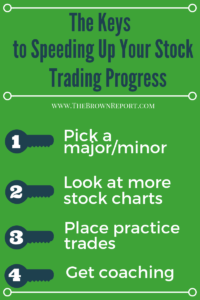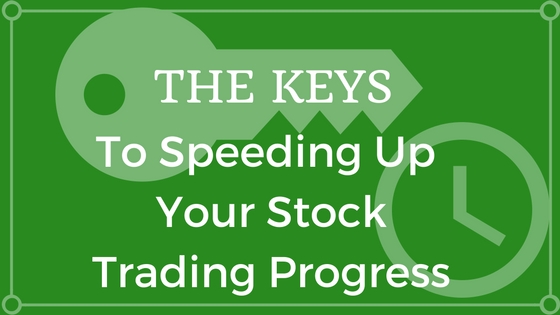“How long does it take to become a full time trader? When can I start making money from my trades?” are questions I get often, and it makes complete sense that you would want to start making a profit as soon as possible.
There are four things you can do to speed up your stock trading progress to be great at spotting patterns and to execute on your plan for Financial Freedom.
Money is the result of you doing something well. With trading, you want to get paid for spotting predictable patterns that you can capitalize off of. And in the stock market, that can typically happen 70-80% of the time based on certain patterns. What can you do to speed up the process of becoming proficient in spotting patterns, which ideally leads to profit and financial goals met?
Let’s break down four keys to do so:
1.) Pick a “Minor” and a “Major”
There is a lot to learn in this industry. It can be compared to college, where any person or any ethnicity or background can apply and be accepted. In the stock market, as long as you have a social security number, you can trade. But just like college, you have to decide what to major and then what to minor in. What is the ultimate goal? What do you want to become proficient at?
What happens if you do:
Once you have a solid foundation of the stock market, become “laser focused” and have a primary and a secondary strategy that is “working for you”. This major could be in buying stocks, ETFs, calls, puts, spreads, covered calls, etc and then stick to it. And then minor in something that will support your major. For example, you may major in the “w” pattern, and your minor is buying call options when you see that pattern.
Major = pattern
Minor = strategy
What happens if you don’t:
You can get “shiny object syndrome” – once you see something that someone mentions on the internet or another forum, you want to jump right on it! Even if you do not have full knowledge about that stock or even the strategies to trade it. Going back to the college analogy, if you are going to school to become a General Partitioner Doctor, you’re not going to jump at each Art History or Debate class that pops up. That may make you confused and waste time and money. It is the same in the stock market, you may spend too much time or money on trying to learn every single strategy that comes up. Give yourself some time to learn the basics before moving on to the “fancy stuff”. If you pick a major in a minor in the stock market, you are not going to be sidetracked by each new shiny trade or strategy that goes by.
A point to note along with this is that it does take time to master trading strategies. Sometimes new traders rush in and if they are not immediately seeing their bank account skyrocket up, they feel like this isn’t for them or they aren’t “good at it”. I would challenge that when you went to college, did you ever get some good grades in most classes and a couple you didn’t? You may loose some money or a trade that doesn’t work out, but the big picture is with some time, you will be participating in ways to make you money. Do not loose the overall scope.
2.) Look at more stock charts
The goal is to increase your exposure at looking at stock charts and also finding charts that support your major and minor that you already picked. Now that you know what you are looking for, how quickly and accurately can you identify it?
What happens if you do:
You will be able to spot trades that fit your style more easily and quickly. Your eyes will be trained to look for a set up or pattern that you have studied, then when you see it ready in the market, you are ready to capitalize on it. And that will help you get to your financial goal.
When I started trading years ago, I would look at one hundred charts a day for at least a year. It helped me see if my predictions were right and being able to recognize if the patterns follow. Now I have a keen eye for spotting where I believe the chart is going to go.
Look at it this way, if someone doesn’t know a career path they want to take, trying out different jobs will help them recognize what they are good at and what they don’t like. They could take a job as a waiter and identify they aren’t good with interacting with a ton of people, and so on with other jobs they try. They see a pattern of what works and what doesn’t. With a stock chart, the more you look at them, the more you see you don’t want to trade and certain patterns of profit and loss.
What happens if you don’t:
The process of learning how to trade will be slower and you will not as easily recognize potential trades from the major and minor you have studied.
3.) Place more practice trades
The goal of practice trading is to simulate the real environment. Why would you want to do this?
 What happens when you do:
What happens when you do:
You get familiar with the trading platform. You can answer these questions about yourself, “Do I know if I should be buying to open? Selling to close? The right trade execution?” It is better to know these answers before putting real money on the table.
You get use to making decisions. Did you set a stop loss? Did you get out of the trade or get greedy? It will trigger some of the emotions of actual trading, so you will understand what you would do if it were real money. You can get as close to simulating those emotions as possible, noting what you would do if the trade goes south or when you hit your target profit. These are things you need to find out, just as a pilot would find out some of his emotions by simulating flying before actually getting up in the air. This is something that really needs to be drilled down, because it may be something that is not done enough.
When I am asked how long it takes to start real trading, I always say that it depends on a lot of factors, including how often you are virtually trading. Try ten virtual trades in a row, and you want to be right 7/10 times or net-positive. Then you are ready.
What happens if you don’t:
You’re never ready for the real environment. There will be surprise factors of emotion of how you handle trades, and you may make mistakes that would have otherwise been caught.
4.) Get coaching
This helps with all three previous keys. Sometimes we see clients reach out to get coaching from new traders, but we want to reach out to those who are seasoned and skilled traders whom we can learn from. Look at the olympics, all of those who were competing had what? Every single one had a coach!
What happens if you do:
When the athletes have a coach, they improve faster than if they did not have one. And that is our goal: compressing time. A coach helps you pick a major and a minor and they help you go through the charts with you. Feedback cuts back on the window of doing the wrong thing, finding stocks on your own, or making mistakes. If you get some insight before you dive in, you can get feedback to walk you through and save some time.
For example, we recently had a Group Coaching member come on live in the webinar in our latest session and break down her thoughts regarding a trade she was making. We were able to ask questions step-by-step to see what she was seeing, and help her open her eyes to things she needed to catch, like support and resistance lines. It was awesome to bring her on the line and answer her questions, and I am sure it saved her some time in looking at the trade the wrong way.
What happens if you don’t:
The process for learning how to trade will be slower and you may have to learn from your mistakes the hard way. You won’t have the support and feedback that you need.
Make sure you check out the Power Trades University program that we have. We meet for two hours every Monday from 8-10pm EST to look over the overall market, look into potential trades from previous weeks, and also plenty of opportunity for the members to ask live questions. We analyze the type of market we are currently in and the mentality we should be having. If you have not had the experience in trading in different markets, you may not know what to look for. We get a lot of positive feedback from the members and how it is helping them. But if it is not me, find a coach that you resonate with and understand well to help you.
During the week, you get the support of the other members in Power Trades University. You can ask your coach questions about what you are trading so you can get answers even before the live session on Monday. The support of others that are learning with you helps growth exponentially.
If you are doing steps 1-3, learning your major and minor, looking at tons of charts, and are virtual trading, it is time to take it to the next level and get a coach to complete step 4. If you are doing all 4 steps at once, you can’t help but grow faster. You take the results from what you are getting from the first 3 steps to your coach every week and get the feedback you need. This will help you master the skills quicker and reach your financial goals.
